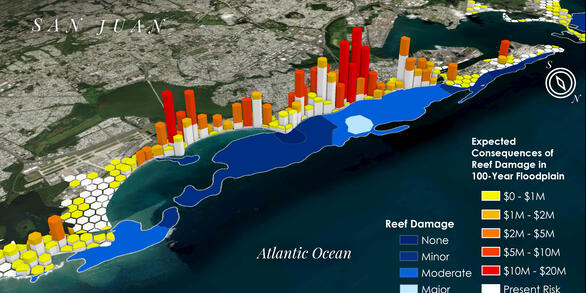Publications
Scientific reports, journal articles, and information products produced by USGS Pacific Coastal and Marine Science Center scientists.
Filter Total Items: 1378
Ascension-Monterey Canyon system: history and development
No abstract available.
Authors
H. Gary Greene, Karen R. Hicks
Sedimentology and petroleum occurrence, Schoolhouse Member, Maroon Formation (Lower Permian), northwestern Colorado
The Lower Permian Schoolhouse Member of the Maroon Formation forms a partly exhumed petroleum reservoir in the Eagle basin of northwestern Colorado. The Schoolhouse consists mainly of yellowish gray to gray, low-angle to parallel bedded, very fine to fine-grained sandstone of eolian sand-sheet origin; interbedded fluvial deposits are present in most sections. Geological and geochemical...
Authors
Samuel Johnson, Christopher J. Schenk, D. L. Anders, Michele L.W. Tuttle
Prodigious submarine landslides on the Hawaiian Ridge
The extensive area covered by major submarine mass wasting deposits on or near the Hawaiian Ridge has been delimited by systematic mapping of the Hawaiian exclusive economic zone using the side‐looking sonar system GLORIA. These surveys show that slumps and debris avalanche deposits are exposed over about 100,000 km2 of the ridge and adjacent seafloor from Kauai to Hawaii, covering an...
Authors
James G. Moore, David A. Clague, R. T. Holcomb, Peter W. Lipman, William R. Normark, Michael E. Torresan
Salinity variations in submarine hydrothermal systems by layered double-diffusive convection
Various mechanisms have been proposed to explain the salinity variations in vent fluids of seafloor geothermal systems. New experiments reacting diabase and evolved seawater were carried out to reproduce earlier published observations of Cl depletions attributed to formation of an ephemeral Cl-bearing mineral. The absence of any Cl depletions in the present study suggests that the...
Authors
James L. Bischoff, Robert J. Rosenbauer
Estimates of the suspended sediment reference concentration (Ca) and resuspension coefficient (γ0) from near-bottom observations on the California shelf
Near-bottom current and suspended sediment measurements above a sandy clayey silt bed on the California continental shelf are used to estimate the near-bed suspended sediment reference concentration, Ca, and the bed shear stress, τ0. A proposed model contends that Ca should be proportional to the normalized excess shear stress acting on the sediment grains and to the availability of...
Authors
D.E. Drake, David A. Cacchione
Hydrocarbon gases in sediment of the Voring Plateau, Norwegian Sea
Geochemical studies at three ODP Leg 104 sites on the Wring Plateau help define the distribution of hydrocarbon gases in sediment of this prominent feature of the Norwegian continental margin. Low levels of hydrocarbon gas were encountered in sediment of the outer part of the plateau, but sediment of the inner part of the plateau is very gassy. The molecular composition of inner plateau...
Authors
Keith A. Kvenvolden, Margaret Golan-Bac, T.J. McDonald, R.C. Pflaum, J.M. Brooks
Organic matter at sites 642, 643, and 644, ODP Leg 104
Sedimentary extractable organic matter was analyzed at three ODP Leg 104 sites in the Norwegian Sea. Organic carbon content ranged from less than 0.1% to a maximum of 1.8%. Extractable organic matter content and unresolved complex mixture concentrations were low and randomly distributed. Low levels of aliphatic (branched and normal) and aromatic hydrocarbons were detected in all of the...
Authors
T.J. McDonald, Mahlon C. Kennicutt, J.M. Brooks, Keith A. Kvenvolden
Organic geochemistry on Leg 104
The Leg 104 organic geochemistry program consisted of monitoring (a) hydrocarbon gases, (b) organic and inorganic carbon, and (c) parameters resulting from Rock-Eval pyrolysis at three sites on the Vdring Plateau. The results amplify some of those obtained earlier on Deep Sea Drilling Project (DSDP) Leg 38. In a regional sense there is an inverse correlation between amounts of...
Authors
Keith A. Kvenvolden, T.J. McDonald
Marine magnetic gradiometer: A tool for the seismic interpreter
The marine magnetometer has been used since the early '50s as an ancillary tool on vessels conducting regional and local seismic surveys. Emphasis on marine magnetic data by academia has led to major discoveries about the structure of the earth's crust, such as the association of shallow, crustal magnetic anomalies to seafloor spreading and long-wavelength anomalies to deep crustal...
Authors
Richard J. Wold, Alan K. Cooper
Morphology and growth history of Delgada Fan: Implications for the Neogene evolution of Point Arena Basin and the Mendocino Triple Junction
Long-range side scan (GLORIA) sonographs and seismic reflection data acquired during a survey of the western U.S. Exclusive Economic Zone in 1984, coupled with information from Deep Sea Drilling Project sites, provide new insights into the growth and evolution of the Delgada Fan. Construction of the fan commenced in the latest Miocene (∼6 Ma) following the filling of the Neogene Point...
Authors
D.E. Drake, D.A. Cacchione, J.V. Gardner, D. S. McCulloch, D. Masson
Observations in Monterey Canyon and Fan Valley using the submersible Alvin and a photographic sled
No abstract available.
Authors
Stephen L. Eittreim, R.W. Embley, W.R. Normark, H. Gary Greene, C.M. McHugh, W.B. Ryan



